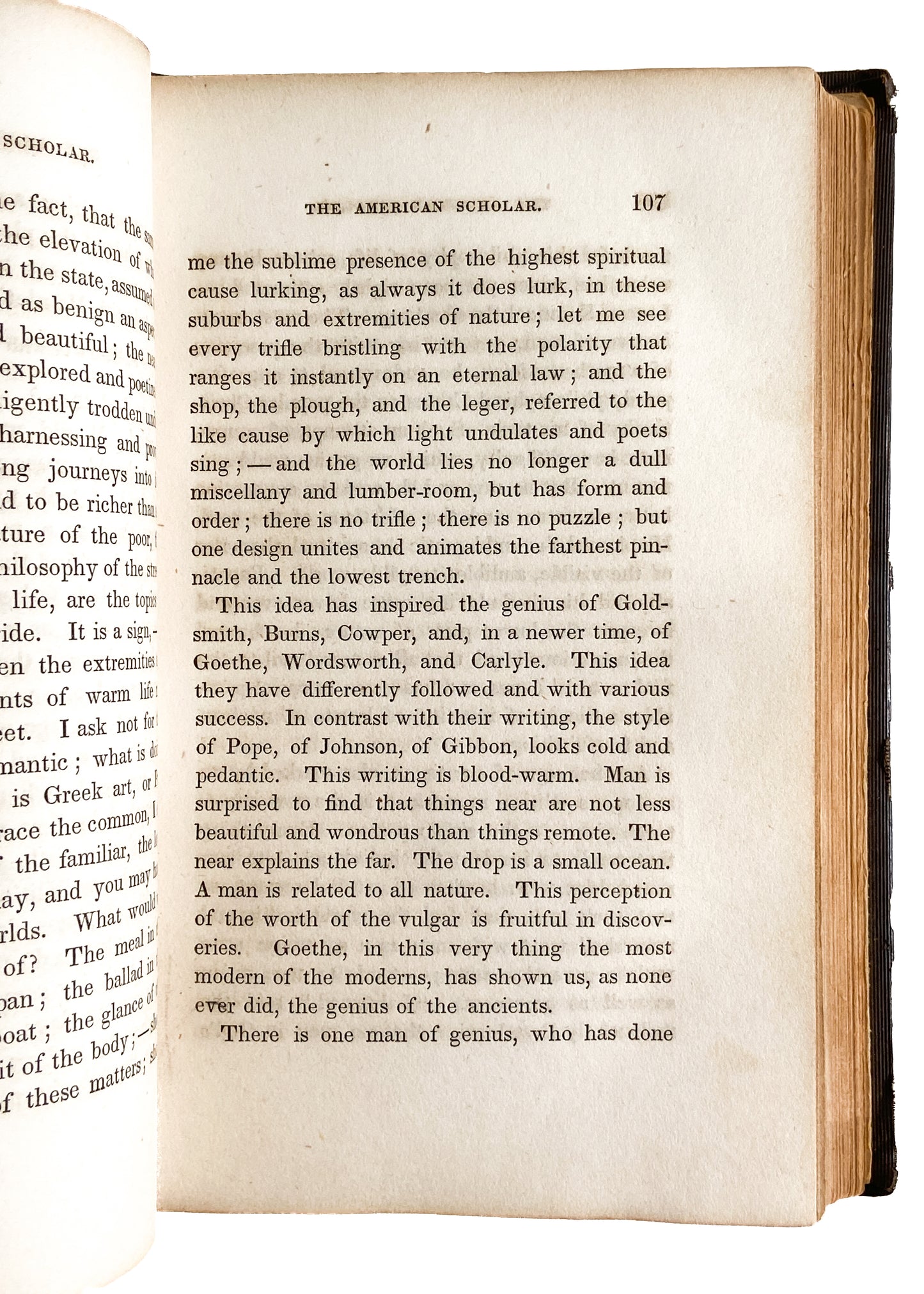Specs Fine Books
1849 RALPH WALDO EMERSON. Lectures and Addresses on Nature. First Edition with Superb Provenance.
1849 RALPH WALDO EMERSON. Lectures and Addresses on Nature. First Edition with Superb Provenance.
Couldn't load pickup availability
A generally well-preserved copy of the first edition of Ralph Waldo Emerson's classic on the role of man in the world, on the "method of nature," transcendentalism, etc.,
And this copy with very fine provenance, crisply signed and dated on the blank ffep, "Chas D. B. Mills, Elyria, March. 1850. No. 280"
Charles De Berard Mills (C. D. B. Mills, 1821–1900) was a prominent figure in the abolitionist movement, and later in the freethought movement, influenced in large part by Emerson and others.
He was born in New Hartford, New York, to Abram Mills and his wife, Grace De Berard Mills. Abram Mills was himself an ardent abolitionist, an early graduate of the Oneida Institute in Whitesboro, a Presbyterian manual labor college founded in 1827 that had religiously liberal leanings. Young Charles Mills attended the Oneida Institute as his father had; by that time, the Institute was led by abolitionist firebrand Beriah Green, who accepted a large number of African American students and held classes for black and white students together, making the Oneida Institute America’s first racially integrated institution of higher education.
Mills arrived in Syracuse in the early 1840s. He met his future wife, Harriet Ann Smith, when he was engaged to educate her privately by her father, a wealthy farmer named David Smith. Charles and Harriet married on July 9, 1845. They resided first in Smyrna, New York, and then Elyria, Ohio. He worked variously as a teacher and a minister, each time losing those positions because of his controversial abolitionist views. While at Elyria, he taught at Western Reserve College, an early center of abolitionist activism, but even there Mills’s stance was considered extreme. He was offered a professorship, but declined because if he were appointed, he knew he would be expected to temper his views.
Charles and Harriet returned to Syracuse in 1851. Charles, or C. D. B. as he preferred to be known, had chosen Syracuse because he hoped to meet the Rev. Samuel Joseph May, a prominent abolition leader in the city; in this he was successful. Mills took a job as bookkeeper for a plant nursery, a job in which his nights and weekends would be his own in which to study and write. He began to earn additional income as a writer and lecturer on abolition and other reform topics.
The choice of Syracuse turned out to be propitious; days after the Millses arrived in Syracuse, the rescue by abolitionists of an escaped slave nicknamed "Jerry" from federal custody made the city briefly the center of the abolitionist universe. Later in her life, Harriet Smith Mills recalled a celebration of the Jerry Rescue, featuring as speakers Gerrit Smith and Lucretia Mott, as the first event of consequence she remembered after moving to Syracuse.
In 1857, the Millses built a fine house at what is now 1074 West Genesee Street. It became a salon of sorts, a ready gathering place for prominent woman’s rights activists, abolitionists, and temperance advocates. This volume was a part of the Genesee Street library collected by Mills. Visitors and house guests of national stature included Frederick Douglass, Elizabeth Cady Stanton, Susan B. Anthony, Lucy Stone, Mott, Carrie Chapman Catt, William Lloyd Garrison, Wendell Phillips, Amos Bronson Alcott, and, our author, one Ralph Waldo Emerson.
At some point during this period, Mills served as minister to the strongly Abolitionist Free Church of Canastota, where he succeeded his mentor, Beriah Green.
He was father of one of the most influential workers for women's suffrage, Harriet May Mills [b.1857].
A few early MSs notes exist, including a lengthier note on the first half page of the text, and some indexing notes in the rear. These may be Charles, his daughter's, or another early owner.
Emerson, Ralph Waldo. Nature; Addresses, and Lectures. Boston and Cambridge. James Munroe and Company. 1849. First Edition. 383 + 8pp.
Good, some chipping to spine, partially relaid, reinforced as handsomely as can be done with the material with color-matched kyvar tape. Textually solid and clean with some very minor foxing, prelims toned. Small tear to one leaf.
Share
















